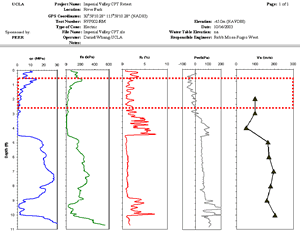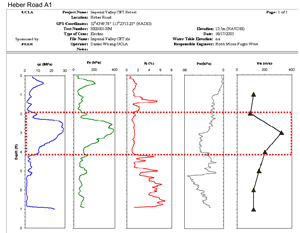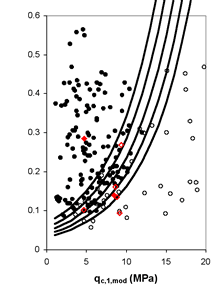This project consisted of retesting of liquefaction and non-liquefaction field case histories in the Imperial Valley with the cone penetration test (CPT). The River Park and Heber Road sites were originally tested using a mechanical cone following the 1979 Imperial Valley Earthquake (Bennett et al., 1981; Youd & Bennett, 1983). These two sites are rich in information because they have experienced several earthquakes in recent history, have been subjected to moderate levels of strong ground shaking, the liquefiable soils have appreciable fines content, and the sites contain a number of non-liquefied data points.
Recent liquefaction case histories databases (Moss et al., 2003) are based on data acquired using the electric cone, following ASTM spec. 5778. Case histories previously explored with the mechanical cone are now obsolete and the data non-standard. The electric cone data at the Heber Road and River Park sites is summarized in Figure 1.


Fig. 1. Example CPT data from River park (left) and Heber Road (right)
showing critical layers for liquefaction triggering
These important sites can now be incorporated into liquefaction case history databases and used in back-analysis of liquefaction triggering. The data points are overlaid on the worldwide liquefaction case history inventory in Figure 2.

Fig. 2. New liquefaction/non-liquefaction case histories, corrected for
friction ratio,
shown with probabilistic liquefaction triggering curves
and worldwide database of Moss & Seed (2004).
Filled symbols are liquefaction
data points and hollow symbols are non-liquefaction data points.